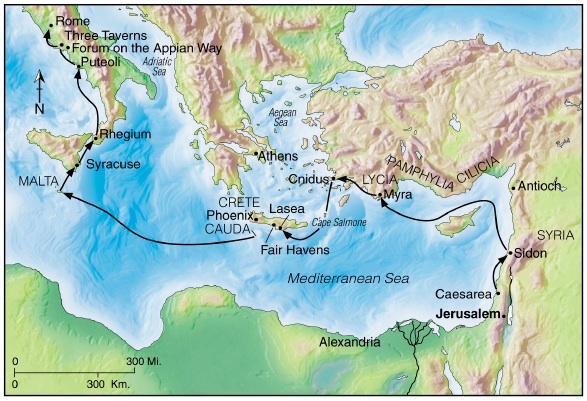| Alexandian Ship running aground |
Theme Number 59 The Storm at Sea
Act 27:13 And a light breeze from the south sprang up, so that they supposed they were now sure of their purpose. So weighing anchor they ran along the coast of Crete, hugging the shore.
Act 27:14 But it was not long before a furious north-east wind, coming down from the mountains, burst upon us and carried the ship out of her course.
Act 27:15 She was unable to make headway against the gale; so we gave up and let her drive.
Act 27:16 Then we ran under the lee of a little island called Cauda, where we managed with great difficulty to secure the boat;
Act 27:20 Then, when for several days neither sun nor stars were seen and the terrific gale still harassed us, the last ray of hope was now vanishing. WNT
Act 27:17 and, after hoisting it on board, they used frapping-cables to undergird the ship, and, as they were afraid of being driven on the Syrtis quicksands, they lowered the gear and lay to.
Act 27:18 But, as the storm was still violent, the next day they began to lighten the ship;
Act 27:19 and, on the third day, with their own hands they threw the ship's spare gear overboard.
Barnes Undergirding the ship - The ancients were accustomed to pass cables or strong ropes around a vessel to keep the planks from springing or starting by the action of the sea. This is now called “frapping” a vessel. The operation of “frapping” a vessel is thus described in Falconer’s Marine Dictionary. “To frap a ship is to pass four or five turns of a large cable-laid rope round the hull or frame of a ship to support her in a great storm, or otherwise, when it is apprehended that she is not strong enough to resist the violent efforts of the sea.”
Syrtis - the quicksands - There were two celebrated syrtes, or quicksands, on the coast of Africa, called the greater and lesser. They were vast beds of sand driven up by the sea, and constantly shifting their position, so that it could not be known certainly where the danger was. As they were constantly changing their position, they could not be accurately laid down in a chart. The sailors were afraid, therefore, that they should be driven on one of those banks of sand, and thus be lost.
| Wrecked on Malta |
No comments:
Post a Comment